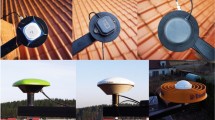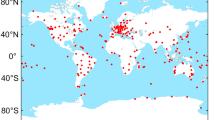Abstract
We use one vector and two pressure sensors to form a sparse large aperture L-shape array for high performance two-dimensional (2D) direction of arrival (DOA) and frequency estimation. Because the number of sensors is small and there is only one vector sensor in the presented array, thus, the installation of sensors in the array is simpler and installation error is smaller, than the conventional array. Meanwhile, a high performance 2D DOA and frequency estimation method is presented. Firstly, utilizing single vector sensor and based on the ESPRIT, a group coarse 2D DOA and frequency parameters are obtained. Secondly, to restrain space noise or interference, a matrix filter is utilized to process the covariance matrix which comes from sensor array, so as to form a new covariance matrix which possesses high signal to noise ratio. Thirdly, utilizing the new covariance matrix and based on the ESPRIT again, accurate but ambiguity angles estimates are obtained. Fourthly, one signal power estimator and one optimization method are presented to solve the angle ambiguity and frequency ambiguity problems, respectively. The proposed method gains a high performance 2D DOA and frequency estimation results. Numerical simulations are performed to verify the feasibility of the proposed method.









Similar content being viewed by others
References
Lu, S., Sun, J., Wang, G., et al. (2012). A mixing vector based an affine combination of two adaptive filters for sensor array beamforming. Progress in Electromagnetics Research, 122, 361–387.
Zhang, X., & Xu, D. (2008). Deterministic blind beamforming for electromagnetic vector sensor array. Progress in Electromagnetics Research, 84, 363–377.
Nehorai, A., & Paldi, E. (1994). Acoustic vector-sensor array processing. IEEE Transactions on Signal Processing, 42(9), 2481–2491.
Hochwald, B., & Nehorai, A. (1996). Identifiability in array processing models with vector-sensor applications. IEEE Transactions on Signal Processing, 44(1), 83–95.
Tichavský, P., Wong, K. T., & Zoltowski, M. D. (2001). Near-field/far-field azimuth and elevation angle estimation using a single vector hydrophone. IEEE Transactions on Signal Processing, 49(11), 2498–2510.
Xu, Y., & Liu, Z. (2007). Frequency-azimuth-elevation determination with a single acoustic vector-sensor involved in a reflecting boundary. Circuits, Systems & Signal Processing, 26(6), 875–895.
Xu, Y., Liu, Z., & Cao, J. (2007). Perturbation analysis of conjugate MI-ESPRIT for single acoustic vector-sensor-based noncircular signal direction finding. Signal Processing, 87(7), 1597–1612.
Junwei, C. H. Z. (2004). Two-dimensional direction finding for low altitude target based on intensity measurement using an acoustic vector-sensor. Chinese Journal of Acoustics, 23(3), 278–288.
Xiaofei, Z., Ming, Z., Han, C., et al. (2014). Two-dimensional DOA estimation for acoustic vector-sensor array using a successive MUSIC. Multidimensional Systems and Signal Processing, 25(3), 583–600.
Le Bihan, N., Miron, S., & Mars, J. (2007). MUSIC algorithm for vector-sensors array using biquaternions. IEEE Transactions on Signal Processing, 55(9), 4523–4533.
Yang, L., & Ho, K. C. (2010). Alleviating sensor position error in source localization using calibration emitters at inaccurate locations. IEEE Transactions on Signal Processing, 58(1), 67–83.
Ma, Z., & Ho, K. C. (2014). A study on the effects of sensor position error and the placement of calibration emitter for source localization. IEEE Transactions on Wireless Communications, 13(10), 5440–5452.
Chen, H., Bao, Y., & Ser, W. (2015). Effects of sensor position errors on far-field/near-field wideband beamformers for microphone arrays. IEEE Sensor Journal, 15(9), 4812–4825.
Roy, R., & Kailath, T. (1989). ESPRIT-estimation of signal parameters via rotational invariance techniques. IEEE Transactions on Acoustics, Speech, and Signal Processing, 37(7), 984–995.
Boyd, S. P., & Vandenberghe, L. (2004). Convex optimization. Cambridge: Cambridge University Press.
Rao, S. S. (1984). Optimization: Theory and applications. London: Wiley.
Wang, Y., Zhou, J., & Kikuchi, H. (2016). Performance of a three-dimensional antenna array and its application in DOA estimation. Wireless Personal Communications, 89(2), 521–537.
Wang, L., Yang, L., Wang, G., et al. (2015). DOA and polarization estimation based on sparse COLD array. Wireless Personal Communications, 85(4), 2447–2462.
Wen, F. Q., & Zhang, G. (2015). Multi-way compressive sensing based 2D DOA estimation algorithm for monostatic MIMO Radar with arbitrary arrays. Wireless Personal Communications, 85(4), 2393–2406.
Zhou, M., & Zhang, X. (2015). Joint estimation of angle and polarization for bistatic MIMO radar with polarization sensitive array using dimension reduction MUSIC. Wireless Personal Communications, 81(3), 1333–1345.
Cao, R., Wang, C., & Zhang, X. (2015). Two-dimensional direction of arrival estimation using generalized ESPRIT algorithm with non-uniform L-shaped array. Wireless Personal Communications, 84(1), 321–339.
Acknowledgements
This work was supported in part by the National Natural Science Foundations of China under Grant Nos. 61501319, 61505140, 51275349 and 51575387, in part by the National Marine economy innovation development area demonstration Project No. cxsf2014-2.
Author information
Authors and Affiliations
Corresponding author
Rights and permissions
About this article
Cite this article
Jiang, Jj., Duan, Fj. & Wang, Xq. 2D DOA and Frequency Estimation Method with One Vector-Sensor and Two Pressure Sensors Based on ESPRIT and Signal Power. Wireless Pers Commun 97, 5385–5399 (2017). https://doi.org/10.1007/s11277-017-4785-z
Published:
Issue Date:
DOI: https://doi.org/10.1007/s11277-017-4785-z




